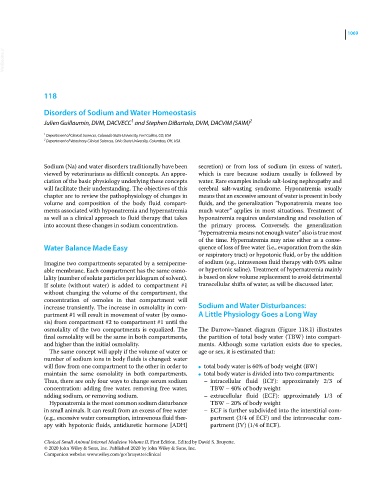Page 1131 - Clinical Small Animal Internal Medicine
P. 1131
1069
VetBooks.ir
118
Disorders of Sodium and Water Homeostasis
1
Julien Guillaumin, DVM, DACVECC and Stephen DiBartola, DVM, DACVIM (SAIM) 2
1 Department of Clinical Sciences, Colorado State University, Fort Collins, CO, USA
2 Department of Veterinary Clinical Sciences, Ohio State University, Columbus, OH, USA
Sodium (Na) and water disorders traditionally have been secretion) or from loss of sodium (in excess of water),
viewed by veterinarians as difficult concepts. An appre- which is rare because sodium usually is followed by
ciation of the basic physiology underlying these concepts water. Rare examples include salt‐losing nephropathy and
will facilitate their understanding. The objectives of this cerebral salt‐wasting syndrome. Hyponatremia usually
chapter are to review the pathophysiology of changes in means that an excessive amount of water is present in body
volume and composition of the body fluid compart- fluids, and the generalization “hyponatremia means too
ments associated with hyponatremia and hypernatremia much water” applies in most situations. Treatment of
as well as a clinical approach to fluid therapy that takes hyponatremia requires understanding and resolution of
into account these changes in sodium concentration. the primary process. Conversely, the generalization
“hypernatremia means not enough water” also is true most
of the time. Hypernatremia may arise either as a conse-
Water Balance Made Easy quence of loss of free water (i.e., evaporation from the skin
or respiratory tract) or hypotonic fluid, or by the addition
Imagine two compartments separated by a semiperme- of sodium (e.g., intravenous fluid therapy with 0.9% saline
able membrane. Each compartment has the same osmo- or hypertonic saline). Treatment of hypernatremia mainly
lality (number of solute particles per kilogram of solvent). is based on slow volume replacement to avoid detrimental
If solute (without water) is added to compartment #1 transcellular shifts of water, as will be discussed later.
without changing the volume of the compartment, the
concentration of osmoles in that compartment will
increase transiently. The increase in osmolality in com- Sodium and Water Disturbances:
partment #1 will result in movement of water (by osmo- A Little Physiology Goes a Long Way
sis) from compartment #2 to compartment #1 until the
osmolality of the two compartments is equalized. The The Darrow–Yannet diagram (Figure 118.1) illustrates
final osmolality will be the same in both compartments, the partition of total body water (TBW) into compart-
and higher than the initial osmolality. ments. Although some variation exists due to species,
The same concept will apply if the volume of water or age or sex, it is estimated that:
number of sodium ions in body fluids is changed: water
will flow from one compartment to the other in order to ● total body water is 60% of body weight (BW)
maintain the same osmolality in both compartments. ● total body water is divided into two compartments:
Thus, there are only four ways to change serum sodium – intracellular fluid (ICF): approximately 2/3 of
concentration: adding free water, removing free water, TBW – 40% of body weight
adding sodium, or removing sodium. – extracellular fluid (ECF): approximately 1/3 of
Hyponatremia is the most common sodium disturbance TBW – 20% of body weight
in small animals. It can result from an excess of free water – ECF is further subdivided into the interstitial com-
(e.g., excessive water consumption, intravenous fluid ther- partment (3/4 of ECF) and the intravascular com-
apy with hypotonic fluids, antidiuretic hormone [ADH] partment (IV) (1/4 of ECF).
Clinical Small Animal Internal Medicine Volume II, First Edition. Edited by David S. Bruyette.
© 2020 John Wiley & Sons, Inc. Published 2020 by John Wiley & Sons, Inc.
Companion website: www.wiley.com/go/bruyette/clinical

